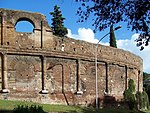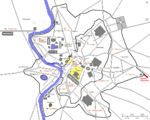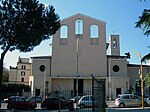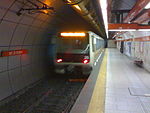Santa Croce in Gerusalemme

The Basilica of the Holy Cross in Jerusalem or Basilica di Santa Croce in Gerusalemme, (Latin: Basilica Sanctae Crucis in Hierusalem) is a Catholic Minor basilica and titular church in rione Esquilino, Rome, Italy. It is one of the Seven Pilgrim Churches of Rome. According to Christian tradition, the basilica was consecrated circa 325 to house the relics of the Passion of Jesus Christ brought to Rome from the Holy Land by Empress Helena, mother of Roman Emperor Constantine I. The basilica's floor was covered with soil from Jerusalem, thus acquiring the title in Hierusalem; it is not dedicated to the Holy Cross of Jerusalem, but the basilica was considered in a sense to be "in Jerusalem" (much in the way that an embassy today is considered extraterritorial). The current Cardinal Priest of the Titulus S. Crucis in Hierusalem is Juan José Omella.
Excerpt from the Wikipedia article Santa Croce in Gerusalemme (License: CC BY-SA 3.0, Authors, Images).Santa Croce in Gerusalemme
Viale Castrense, Rome Tuscolano
Geographical coordinates (GPS) Address Nearby Places Show on map
Geographical coordinates (GPS)
| Latitude | Longitude |
|---|---|
| N 41.8878 ° | E 12.5164 ° |
Address
Viale Castrense
00182 Rome, Tuscolano
Lazio, Italy
Open on Google Maps










